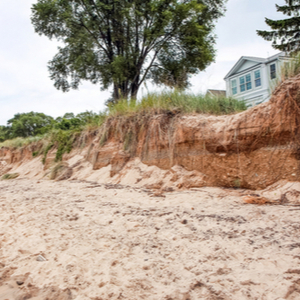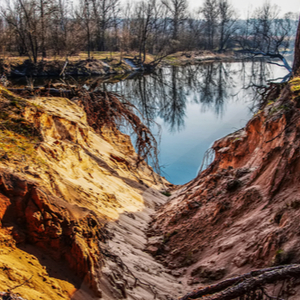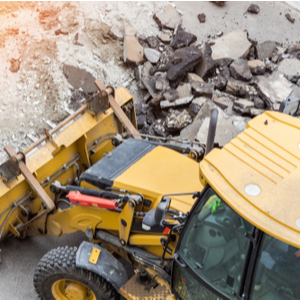 Erosion is a natural process, but excessive stormwater runoff can cause erosion to occur much faster than it normally would. Erosion is even more of a concern on construction sites since construction typically occurs on bare soil. Excessive stormwater erosion can lead to a lower level of groundwater, negatively impact drinking water and put biological habitats in jeopardy.
Erosion is a natural process, but excessive stormwater runoff can cause erosion to occur much faster than it normally would. Erosion is even more of a concern on construction sites since construction typically occurs on bare soil. Excessive stormwater erosion can lead to a lower level of groundwater, negatively impact drinking water and put biological habitats in jeopardy.
It is important for construction sites to have a stormwater pollution prevention plan (SWPPP) in place to reduce the risk of stormwater erosion. It is also helpful to become familiar with the different types of stormwater erosion that can take place on construction sites. There are five primary types of stormwater erosion, which are raindrop erosion, sheet erosion, rill erosion, gully erosion and streambank erosion. The following is an overview of each type and the short- and long-term impact it can have on construction sites.
Raindrop Erosion
A single raindrop does not have much of an impact on soil, but when billions of raindrops crash into bare soil, it can cause erosion. The act of rainfall dislodging soil particles is what is referred to as
raindrop erosion. This type of erosion is the first step in a series of erosion types. It can cause the soil to break apart and move more than a meter from its original spot, which can change the landscape of your construction site.
As raindrop erosion causes soil particles to splash around and move, the particles can begin to block areas between your construction aggregate. When this blockage occurs, it is even more challenging for the rain to absorb into the underlying soil, resulting in an increase in stormwater runoff.
When stormwater runoff increases as a result of a buildup of soil particles between construction aggregate, it can increase the risk of flooding. If the water finds its way towards a water source, it could contaminate drinking water and put the habitat of wildlife at risk. Due to these risks, having proper stormwater management at your construction site is essential.
Sheet Erosion
Sheet erosion is far more subtle than raindrop erosion. Whereas erosion can knock soil loose almost immediately, sheet erosion takes place over time. It is essentially the removal of soil from an area over time through a slow stream of water that carries over the surface.
Raindrop erosion and sheet erosion can work together to contribute to erosion on construction sites. After the impact from the raindrops breaks up the exposed soil, sheet erosion can come along and carry the particles away with stormwater runoff. Any soil particles that are weakened by raindrops may completely break apart due to sheet erosion.
Sheet erosion is more prone to attack areas that are bare rather than areas where there is vegetation. This makes construction sites increasingly vulnerable. Stormwater management seeks to reduce the effects of sheet erosion by having a proper plan in place to prevent excessive stormwater runoff from occurring.
Rill Erosion
Rill erosion typically occurs after raindrop erosion and sheet erosion. It refers to small pathways or channels that develop less than 30 centimeters below the surface. They are the result of stormwater runoff and can cause damage over time. The good news is that rill erosion is easier to prevent and fix than gully erosion. However, rill erosion can cause a range of other problems.
Perhaps the biggest concern of rill erosion is that it speeds up and provides a pathway for stormwater runoff. It can lead to water flowing through the soil and reaching bodies of water. While it is flowing, the stormwater can pick up pesticides, dirt, bacteria and other contaminants. If the water reaches a water source, which it often does, the water source can become dirty and contaminated, which may affect drinking water. Contaminated drinking water can lead to health issues for both human and animal populations.
Gully Erosion
 Gully erosion is considered the next step after rill erosion. A gully is essentially a much larger rill. Gullies are the direct result of excessive stormwater runoff that removes the soil, and they can be incredibly challenging to fill. Since they are so hard to fix, it is important to do everything possible to prevent them from developing.
Gully erosion is considered the next step after rill erosion. A gully is essentially a much larger rill. Gullies are the direct result of excessive stormwater runoff that removes the soil, and they can be incredibly challenging to fill. Since they are so hard to fix, it is important to do everything possible to prevent them from developing.
Gully erosion can also change the landscape of the construction site, along with potentially having a negative impact on nearby wildlife, the quality of drinking water and other things.
Like sheet erosion and rill erosion, gully erosion is more likely to develop in areas where there is less vegetation, such as construction sites. However, stormwater management professionals can
reduce the risk of erosion at your construction site with the strategic construction of stormwater prevention systems.
Streambank Erosion
 Streambank erosion refers to the wearing away of the soil on the bank of a stream. A stream is essentially a small river that typically leads to another body of water. As the soil erodes away from the streambank, the particles, which are dirty and contaminated, can end up in the stream. This not only contaminates the stream, but the contamination can lead to larger bodies of water, like rivers and lakes, and create an even bigger concern.
Streambank erosion refers to the wearing away of the soil on the bank of a stream. A stream is essentially a small river that typically leads to another body of water. As the soil erodes away from the streambank, the particles, which are dirty and contaminated, can end up in the stream. This not only contaminates the stream, but the contamination can lead to larger bodies of water, like rivers and lakes, and create an even bigger concern.
As it relates to construction sites, the erosion of streambanks can significantly affect the landscape of the construction site. Construction near streams and rivers can be made even more difficult if the size of the stream is expanding due to streambank erosion.
Stormwater management can reduce the risk of stormwater erosion of streambanks to ensure your construction plans are not affected and that construction efforts do not contaminate nearby water or contribute to flash flooding.
Call Stormwater Management Experts
 Give our stormwater management experts at Dirt Connections a call today to learn more about stormwater erosion on construction sites. We offer stormwater management services, and we can construct, improve or maintain the stormwater pollution prevention plan at your construction site. Our professional and hard-working team has the knowledge and experience necessary to help you through each step of the stormwater management process, so you can focus solely on meeting your construction goals. Give us a call today to get more information or to get started on stormwater management for your construction site.
Give our stormwater management experts at Dirt Connections a call today to learn more about stormwater erosion on construction sites. We offer stormwater management services, and we can construct, improve or maintain the stormwater pollution prevention plan at your construction site. Our professional and hard-working team has the knowledge and experience necessary to help you through each step of the stormwater management process, so you can focus solely on meeting your construction goals. Give us a call today to get more information or to get started on stormwater management for your construction site.
Summary

Dirt Connections was started with one goal in mind: providing quality residential and commercial construction services to clients on time and on budget. Reach out for more information on how we can support your next project.
For your convenience our estimates are free and by appointment. Call 703-940-9949 for a free estimate today!










































